Key Takeaways
Building a tour guide app requires clear planning, including defining your audience, features, and platform choice.
Incorporating AI, AR, and personalized recommendations enhances user engagement and sets your app apart in a competitive market.
Understanding the cost to develop a tour guide app helps balance features and budget effectively.
Studying successful apps like TripAdvisor and Omio provides practical insights into design, functionality, and monetization strategies.
Addressing common challenges such as data accuracy, security, and scalability ensures a smooth development process and better user satisfaction.
Partnering with experts like JPLoft simplifies the journey from concept to launch, offering technical guidance and strategic support at every stage.
Exploring new destinations has evolved beyond simply following maps; travelers now crave personalized, immersive experiences. A Tour Guide App makes discovering cities and cultures smarter, easier, and more engaging by offering curated attractions, real-time navigation, and tailored recommendations.
How to build a tour guide app? To make a tour guide app, start by defining your target audience and core features such as personalized itineraries, offline maps, and AI-based recommendations. Next, focus on intuitive UI/UX design, seamless navigation, and integrating technologies like GPS, AI, and push notifications. Finally, plan for testing, deployment, and ongoing updates to ensure your app remains reliable and engaging for travelers.
For entrepreneurs and businesses, this is an exciting opportunity to learn how to build a Tour Guide App that meets modern travelers’ expectations. This guide will walk you through key features, development steps, AI integration, costs, and strategies to create a successful app in 2025, serving as a complete tour guide app development guide.
What is a Tour Guide App?
A Tour Guide App is a mobile application designed to assist travelers in exploring new destinations efficiently. It combines location-based services, curated itineraries, and sometimes augmented reality to provide real-time information about tourist attractions, restaurants, historical sites, and local experiences.
If you are wondering how to create a travel app that delivers these functionalities, it’s important to understand the core features that make an app intuitive and engaging. From interactive maps to offline access, these elements ensure a seamless experience for users.
Moreover, knowing the cost to develop a travel app helps entrepreneurs plan budgets realistically when building a tour guide solution. Modern apps often integrate AI to offer personalized recommendations based on user preferences and travel history, transforming a simple navigation tool into a personal travel assistant.
For businesses aiming to create a tour guide app, mastering these fundamentals ensures that your app meets modern traveler expectations. With this approach, you can plan how to develop a tour guide app that stands out in a competitive market.
How Does a Tour Guide App Work?
A Tour Guide App functions through a seamless flow of steps that connect the user’s actions with smart backend operations. Here’s a step-by-step breakdown:
Step 1: User Registration & Profile Setup
Users start by signing up or logging in, entering travel preferences, language choices, and interests.
This data allows the app to personalize recommendations and create a user-specific experience.
Entrepreneurs aiming to create a tour guide app must ensure smooth onboarding for higher engagement.
Step 2: Location Detection & Mapping
The app uses GPS to determine the user’s real-time location. This enables accurate mapping of nearby attractions, restaurants, and landmarks.
Location data is continuously updated to reflect movement as the user explores.
Step 3: Personalized Itinerary Generation
Based on the user’s profile, preferences, and travel history, the app generates suggested routes and points of interest.
AI can enhance this process, ensuring that the itinerary feels customized and relevant. Developers can leverage this to create an AI Tour guide app.
Step 4: Interactive Navigation & Guidance
The app guides users turn-by-turn, using maps, AR overlays, or voice instructions.
Notifications alert users about nearby attractions or events, ensuring they never miss key points along the route.
Step 5: Content Delivery & Engagement
Users receive information about each location, including historical context, tips, photos, and audio guides. The app dynamically adjusts recommendations as the user moves, creating a live, engaging experience.
Step 6: Offline Access & Data Syncing
Tourists can download maps and guides for offline use. Once online, the app syncs data with servers to update preferences, travel logs, and app analytics. This ensures continuity and reliability.
Step 7: Feedback & Analytics
After completing activities, users can rate locations, provide feedback, and share experiences.
This data helps improve recommendations and informs future AI-driven updates.
Keeping the app updated ensures it continues to evolve.
By following this flow, a Tour Guide App provides a smooth, intelligent, and engaging journey for travelers. Understanding these steps clarifies how to build a tour guide app that operates efficiently and delivers real value.
Features to Include in a Tour Guide App
To make your app stand out in a competitive travel market, it must include features that improve usability, engagement, and personalization. Here are the essential ones:
1] User-Friendly Onboarding
A seamless sign-up and profile setup ensures smooth entry for users. Adding preference-based options at this stage helps you create a tour guide app that feels personalized right from the beginning.
2] Interactive Maps & Navigation
Maps with GPS integration guide travelers to attractions, restaurants, and cultural sites. Many of the top travel app features rely on real-time navigation, which boosts convenience and safety for travelers.
3] Personalized Itineraries
AI analyzes user interests to generate smart itineraries. Businesses aiming to make a tour guide app that feels like a personal travel planner must include customizable routes and suggestions.
4] Augmented Reality (AR) Views
AR enhances real-world exploration by displaying historical facts or directions directly on the screen. It adds immersion and makes the app more engaging.
5] Offline Access
Downloadable guides and maps allow users to continue exploring without internet connectivity, improving accessibility in remote locations.
6] Multi-Language Support
A global audience requires multi-language options. This feature builds inclusivity and ensures higher adoption rates.
7] Push Notifications & Updates
Timely alerts for nearby attractions, deals, or safety information keep users engaged and encourage repeat usage.
8] Visually Rich UI/UX
A clean interface improves user satisfaction. Partnering with a skilled on-demand app development company ensures a balance between aesthetics and functionality.
Here’s a concise table version of your essential tour guide app features:
|
Feature |
Description |
|
User-Friendly Onboarding |
Smooth sign-up with preference-based personalization |
|
Interactive Maps & Navigation |
GPS-enabled maps for attractions and routes |
|
Personalized Itineraries |
AI-driven suggestions and customizable plans |
|
Augmented Reality (AR) Views |
Real-world overlays with facts and directions |
|
Offline Access |
Downloadable guides and maps for offline use |
|
Multi-Language Support |
Options for a global audience |
|
Push Notifications |
Alerts for attractions, deals, and safety updates |
|
Visually Rich UI/UX |
Clean, engaging, and easy-to-use interface |
By combining these features, entrepreneurs can plan how to create a tour guide app that attracts users, builds loyalty, and delivers value across all travel scenarios.
How to Build a Tour Guide App?
Creating a tour guide app requires careful planning, the right technology, and a focus on user experience. Below is a step-by-step guide to make a tour guide app that balances functionality and scalability:
Step 1: Define Your App Concept
Start by clearly defining your app’s purpose and target audience. Are you catering to solo travelers, families, adventure seekers, or luxury tourists? Identify the primary problems your app will solve, such as navigation, itinerary planning, or local recommendations.
-
Conduct market research to understand user needs and competitor offerings.
-
Define your app’s unique value proposition to differentiate it from existing solutions.
-
This step forms the foundation of tour guide app development, ensuring all future decisions align with user expectations.
Step 2: Plan the Features
Careful feature planning ensures your app is both useful and competitive.
-
Core features: GPS-based navigation, offline maps, language translation, real-time updates, weather alerts, and voice-based guidance.
-
Advanced features: AI-generated itineraries, AR-based city tours, personalized recommendations, social sharing, and integrated booking systems.
-
Research about the significant app features to identify elements that increase user engagement.
-
Prioritize features based on your target audience and business goals, balancing complexity with usability.
Step 3: Design Intuitive UI/UX
A seamless and attractive interface is critical for adoption.
-
Focus on a mobile app design that is visually appealing, clean, and easy to navigate.
-
Include accessibility features such as scalable fonts, voice commands, and offline usability.
-
Prototype early and gather feedback through user testing to refine layouts and interactions.
-
Good UI/UX helps create a tour guide app that is functional, enjoyable, and encourages repeat.
Step 4: Choose the Right Tech Stack
Your technology choices impact performance, scalability, and feature integration
-
Frontend: React Native, Flutter, or native iOS/Android development for smooth user experience.
-
Backend: Node.js, Python/Django, or Ruby on Rails for scalability and performance.
-
APIs & Tools: GPS/location services, payment gateways, AI/ML modules, and AR/VR SDKs.
-
Many businesses consult an AI development company to create an AI Tour guide app or build an AI-Based tour guide app, adding smart automation and personalized recommendations.
Step 5: Build and Test the App
Build your app in sprints using agile methodology to allow continuous testing and feedback.
-
Implement features incrementally, testing each module thoroughly.
-
Perform multi-device testing to ensure responsiveness across smartphones and tablets.
-
Validate GPS accuracy, offline map performance, and AI recommendations.
-
Follow travel app testing principles to identify bugs, optimize performance, and enhance security.
Step 6: Integrate AI & Personalization
AI can significantly enhance the value of your app.
-
Generate optimized itineraries based on location, time, weather, and crowd density.
-
Offer personalized recommendations for restaurants, attractions, and activities.
-
Enable predictive insights to suggest the best times to visit popular spots.
-
This step demonstrates practical applications of how to develop a tour guide app with smart automation.]
Step 7: Launch the App
-
Submit your app to major platforms like the Apple App Store and Google Play Store.
-
Optimize app descriptions, visuals, and screenshots for higher visibility.
-
Ensure compliance with privacy regulations and data security standards.
-
Prepare marketing campaigns to attract initial users, including influencer collaborations and social media promotion.
Step 8: Post-Launch Maintenance & Updates
-
Regularly update features, fix bugs, and optimize performance.
-
Monitor user feedback to identify areas for improvement.
-
Implement security upgrades to protect user data.
-
Partnering with a mobile app development company ensures smooth maintenance, scalability, and long-term app success, helping you make a tour guide app that lasts.
Step 9: Analyze & Optimize
-
Track user engagement, retention rates, and feature usage with analytics tools.
-
Use insights to refine app design, AI recommendations, and content.
-
Optimize monetization strategies, such as premium features or in-app bookings, for sustainable revenue.
Step 10: Plan for Future Enhancements
-
Stay updated with trends like AR, VR, voice assistants, and smart travel automation.
-
Consider integrations with local businesses, social features, or eco-friendly travel guides.
-
Continuous innovation ensures your app remains competitive and highly valued by travelers.
Use of AI in Creating a Tour Guide App
Artificial Intelligence is transforming modern travel apps, offering personalized and efficient experiences. Here’s how you can create an AI travel agent effectively to enhance user engagement and streamline travel planning.
Step 1: Personalized Recommendations
AI analyzes user data, including preferences and travel history, to deliver tailored suggestions.
This helps you create an AI tour guide app that acts as a personal travel assistant, offering experiences aligned with individual interests.
Step 2: AI-Powered Virtual Assistance
Voice-enabled chatbots and assistants guide travelers in real-time, answering queries instantly.
You can build an AI-based tour guide app that reduces dependency on human staff while keeping the experience seamless and interactive.
Step 3: Intelligent Itinerary Planning
AI generates optimized itineraries based on location, time, weather, and crowd density.
For example, TripAdvisor’s AI-powered itinerary planner creates day-by-day travel schedules tailored to individual preferences, showcasing the practical benefits of AI in hospitality.
This demonstrates how to develop a tour guide app that uses smart automation to craft personalized schedules, enhancing the overall travel experience.
Step 4: AR and Visual Recognition Integration
AI-driven AR overlays information on landmarks or attractions in real-time. Combining AR in travel apps with AI makes sightseeing interactive, educational, and engaging for users, enhancing the overall app experience.
Step 5: Predictive Analytics for Travel Insights
AI predicts travel trends and user behavior, helping travelers avoid busy routes and book at optimal times. Incorporating predictive insights strengthens the app’s value as a smart and reliable travel companion.
Step 6: Fraud Detection and Security
AI monitors app activity to identify unusual patterns, prevent fraudulent bookings, and protect personal data. This ensures the app remains trustworthy and reliable for all users.
Cost to Build a Tour Guide App
Determining the cost to build a tour guide app depends on multiple factors, including design complexity, chosen features, and technology integrations. While costs can vary, the overall cost to build a tour guide app ranges from $20,000 to $130,000+, depending on the app’s complexity, platform, and integrations. To get a detailed understanding, check out how much does it cost to develop a travel app.
1. Features and Functionality
A simple app with offline maps and search tools costs less, while AI-based personalization, AR navigation, and chatbot support raise expenses.
Reviewing the cost to create an app like Agoda gives insights into how advanced features influence pricing.
2. App Design and User Experience
Investing in an intuitive interface ensures travelers can navigate smoothly. High-quality design elements, animations, and accessibility options improve engagement but increase overall costs.
3. Technology Stack and Integrations
The choice of technologies impacts both performance and budget. AI-driven itinerary planning, AR-based tours, and booking system integrations demand more development hours. Studying the cost to develop a travel app like Visit Dubai highlights how complex integrations can escalate project expenses.
4. Platform Selection
Developing for one platform (Android or iOS) is cheaper, while cross-platform apps cost more but reach wider audiences.
5. Development Team and Location
Hiring costs vary globally. Developers in North America and Europe generally charge more than Asia-based teams, though expertise and quality also matter.
6. Maintenance and Updates
Ongoing expenses like bug fixes, updates, and new feature rollouts add to the long-term cost to create a tour guide app.
Comparison of Costs to Build a Tour Guide App
|
App Type |
Features |
Estimated Cost Range |
|
Basic App |
Maps, offline access, search filters |
$20,000 – $35,000 |
|
Mid-level App |
AI suggestions, AR navigation, chat support |
$40,000 – $70,000 |
|
Advanced App |
Full AI/AR suite, chatbots, booking systems |
$80,000 – $130,000+ |
The actual cost to develop a tour guide app ultimately depends on project scope, desired features, and developer expertise. Partnering with the right team ensures an optimized balance between cost and functionality.
How Tour Guide Apps Make Money: Proven Monetization Models
Tour guide apps can generate steady revenue when supported by the right travel app monetization strategies.
Below are the most effective models:
► In-App Bookings
Apps can earn commissions through hotel, flight, or activity bookings. AI-driven recommendations ensure travelers see relevant options, boosting conversions.
► Freemium with Premium Features
Users enjoy basic features for free, but pay for advanced AI itinerary planners, AR-based navigation, or offline maps. This balance attracts a broad user base while creating upsell opportunities.
► Advertisements & Partnerships
Local restaurants, hotels, and attractions can advertise directly to travelers. Personalized AI-driven ads enhance user engagement without disrupting the experience.
► Subscription Plans
Regular travelers can subscribe to premium services like AI-based concierge support, language translation, or guided AR tours. Predictable income from subscriptions supports long-term growth.
However, while these models sound promising, many startups still struggle. A key reason why online travel apps fail is poor monetization execution such as overloading users with ads or not aligning pricing with customer expectations.
By integrating AI personalization with user-friendly revenue strategies, tour guide apps can sustain profitability and customer loyalty.
Top Tour Guide Apps to Take Inspiration From in 2025
Studying successful apps helps entrepreneurs understand what works in the competitive travel market. Here are some of the best travel apps that offer inspiration for building a top-notch tour guide app:
A] TripAdvisor
A global leader in travel planning, TripAdvisor excels in reviews, recommendations, and real-time booking. Its intuitive interface, user-generated content, and AI-powered suggestions make it a prime example of how to develop an app like TripAdvisor for personalized travel experiences.
B] Omio
Omio simplifies multi-modal travel booking, combining trains, buses, and flights into a single platform. Its seamless integration of routes, ticketing, and scheduling provides a great reference for businesses learning how to create an app like Omio with efficient travel management.
C] GetYourGuide
GetYourGuide focuses on activity and tour bookings worldwide. Its emphasis on personalized recommendations, AR-enabled city tours, and mobile-first design illustrates the kind of interactive features modern travelers expect.
D] Klook
Klook specializes in experiences and local activities, offering instant bookings, QR-based tickets, and multilingual support. Its approach to customer engagement through notifications and AI-driven recommendations sets a benchmark for aspiring tour guide apps.
By analyzing these leaders, entrepreneurs can identify key strategies like AI-powered personalization, seamless booking flows, and multi-platform accessibility.
This insight highlights how to create a tour guide app that not only meets modern traveler expectations but also competes effectively in the travel tech ecosystem.
Challenges for Creating a Tour Guide App in 2025
Building a tour guide app may seem exciting, but several challenges can impact success. Awareness of these hurdles helps in planning effective solutions:
1] Data Accuracy and Real-Time Updates
Travelers rely on accurate information about locations, timings, and availability. Ensuring that data is updated in real-time is critical; otherwise, user trust can decline rapidly.
2] Integration of Advanced Technologies
Features like AI-driven recommendations, AR-based navigation, and voice assistants require careful integration. Mismanaged technology can lead to performance issues, making it one of the key travel app development challenges.
3] Scalability and Performance
As user numbers grow, the app must handle higher loads without crashing or slowing down. Optimizing backend servers and cloud infrastructure is essential for seamless performance.
4] Security and Privacy Concerns
Handling user data, payment information, and location tracking demands robust security measures. Following best practices in travel app security helps protect sensitive information and builds user trust.
5] Regulatory Compliance
Different regions have diverse data protection and travel regulations. Compliance with local laws, including GDPR and other privacy rules, is mandatory for global deployment.
6] User Engagement and Retention
Even a feature-rich app can fail if users don’t find it engaging. Continuous updates, personalized suggestions, and intuitive design are crucial to retaining users over time.
By understanding these challenges early, businesses can plan strategically, prioritize resources, and make a tour guide app development roadmap that mitigates risks while maximizing user satisfaction.
Future Trends in Tour Guide App Development
The travel tech landscape is evolving rapidly, and tour guide apps must adapt to stay competitive. Here are the key trends shaping the future of tour guide apps:
► AI-Powered Trip Planning
AI continues to transform travel planning by creating personalized itineraries based on user preferences, travel history, and real-time data. Leveraging AI tools allows developers to integrate smart recommendations and predictive analytics, enhancing user satisfaction.
► AI-Driven Itineraries
Beyond recommendations, AI can generate complete day-by-day plans, optimizing routes, timing, and activities. By understanding how to build an AI itinerary app, tour guide apps can offer travelers an automated, hassle-free experience while improving engagement and retention.
► Integrated Flight and Transportation Bookings
Future apps are moving toward a one-stop solution where users can book flights, trains, and local transport seamlessly. This saves users time and increases monetization opportunities.
► Advanced UI/UX and Design Innovations
User experience remains a top priority, with emphasis on intuitive navigation, AR overlays, and immersive visuals. Understanding how to design a travel app helps in creating interfaces that are both engaging and easy to use, encouraging users to explore more features.
► Voice Assistance and AR Integration
Voice commands and augmented reality are becoming mainstream in travel apps. Travelers can interact hands-free or visualize destinations through AR, making the experience interactive and informative.
► Predictive Analytics for Personalized Travel
Predictive models can anticipate user needs, from recommending attractions to suggesting off-peak visit times. This data-driven personalization enhances satisfaction and positions your app as a smart travel companion.
► Sustainability and Smart Travel
The trend toward eco-friendly and sustainable travel is gaining traction. Apps can guide travelers toward greener choices, integrating sustainability as part of AI recommendations.
By incorporating these trends, developers can build tour guide apps that are not only modern and user-friendly but also technologically advanced and future-ready.
Talk to JPLoft's Experts and Create a Tour Guide App
Bringing your tour guide app idea to life requires expert guidance, technical know-how, and strategic planning. At JPLoft, a trusted travel app development company, our team specializes in tour guide app development, from concept to launch.
Whether you want to create a tour guide app with AI-powered features, AR navigation, or personalized recommendations, our experts ensure every aspect is designed for seamless user experience and maximum engagement.
Partnering with JPLoft allows you to leverage advanced technologies, scalable architecture, and a robust development process. From wireframing and UI/UX design to testing and post-launch support, we guide you at every step.
Take the first step today, consult with JPLoft to transform your vision into a fully functional tour guide app that stands out in the competitive travel market.
Conclusion
Building a tour guide app in 2025 requires careful planning, the right features, and the latest technology.
From AI-driven recommendations and AR navigation to seamless booking integrations, these apps can deliver personalized and memorable travel experiences.
Understanding the development process, costs, and challenges ensures you’re well-prepared to bring your idea to life.
By learning from successful apps and keeping an eye on emerging trends, you can develop a tour guide app in simple steps that stands out in a competitive market.
With expert guidance and strategic execution, your app can provide value to travelers while generating sustainable revenue.
FAQs
Start by defining your target audience and core features. Choose the right technology stack, design an intuitive UI/UX, and integrate advanced tools like AI and AR. Testing and post-launch support ensure a smooth user experience.
Essential features include GPS-based navigation, offline maps, AI recommendations, AR experiences, booking integration, and real-time updates.
Costs vary depending on features, platforms, design complexity, and AI/AR integration. Basic apps start around $20,000, while advanced AI-driven apps can exceed $100,000.
Yes. AI can personalize recommendations, generate optimized itineraries, provide virtual assistance, and predict user preferences, making the app smarter and more engaging.
Prioritize intuitive navigation, clear layouts, offline access, and personalized recommendations. Integrating AI and AR thoughtfully also enhances engagement and usability.





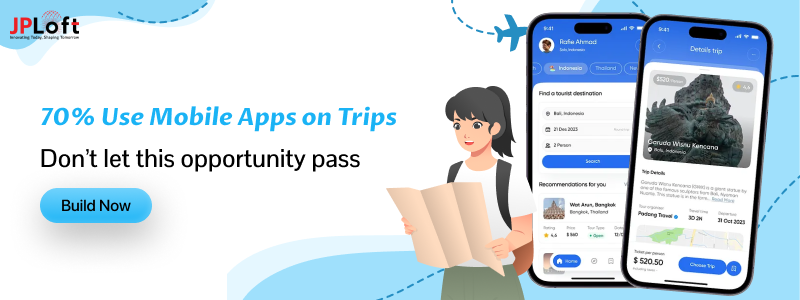
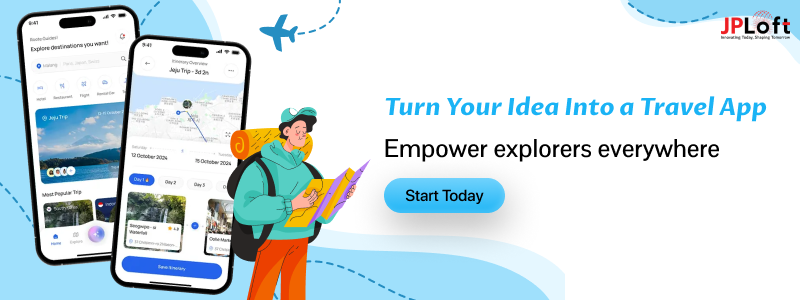

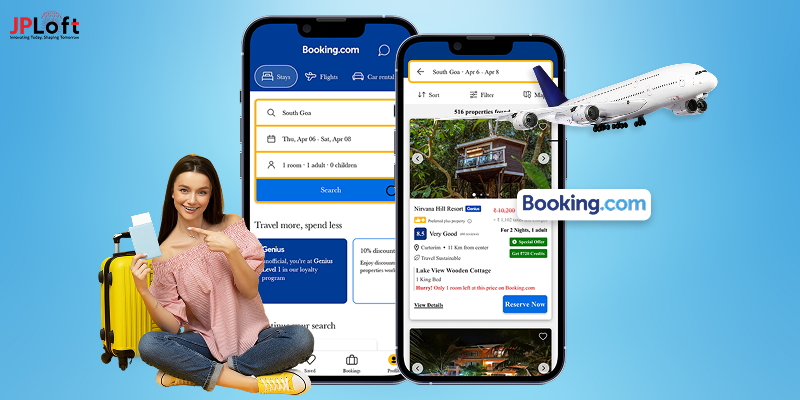
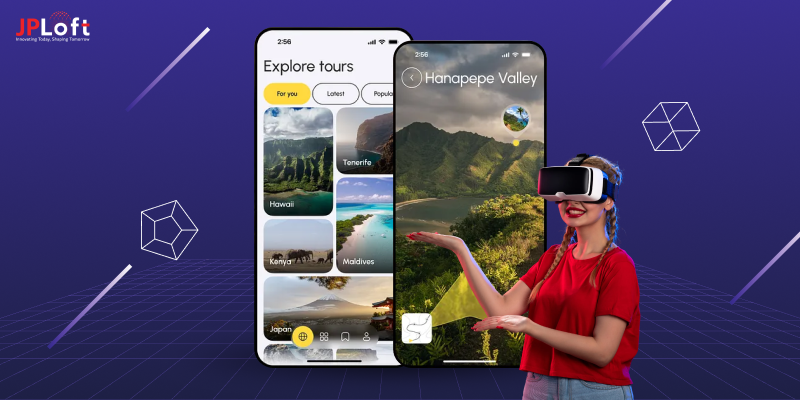
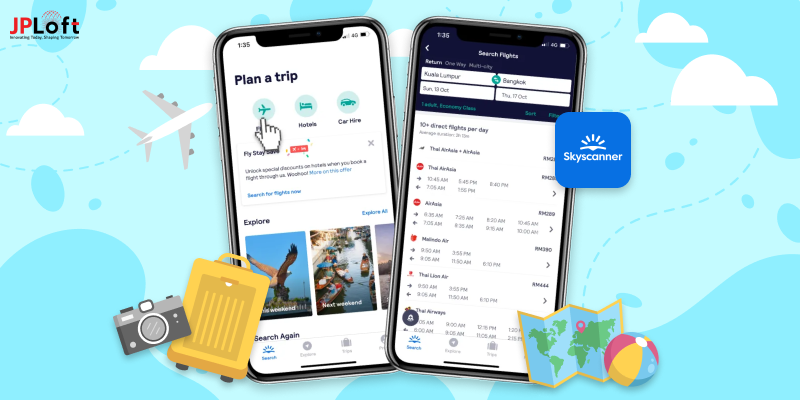


Share this blog